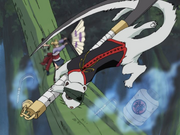Kunoichi101 (talk | contribs) No edit summary |
No edit summary |
||
| (38 intermediate revisions by 29 users not shown) | |||
| Line 1: | Line 1: | ||
| + | {{Infobox/Jutsu |
||
| − | [[Image:Kamatariqj.jpg|thumb|right|Summoning Quick Beheading Dance]] |
||
| + | |ref=<ref>Second Databook, page 211</ref> |
||
| − | * '''Name:''' {{translation|Summoning: Quick Beheading Dance|口寄せ・斬り斬り舞|Kuchiyose: Kirikiri Mai|engtv=Summoning Blade Dance}} |
||
| + | |image=Summoning Beheading Dance.png |
||
| − | * '''Type:''' B-rank, Offensive, All ranges |
||
| + | |kanji=口寄せ・斬り斬り舞 |
||
| − | * '''User:''' [[Temari]] |
||
| + | |unnamed jutsu=No |
||
| − | * '''Debut (Anime):''' ''Naruto'' Episode 125 |
||
| + | |romaji=Kuchiyose: Kirikiri Mai |
||
| − | * '''Debut (Manga):''' Chapter 213 |
||
| + | |literal english=Summoning: Quick Beheading Dance |
||
| + | |english tv=Summoning: Blade Dance |
||
| + | |parent jutsu=Summoning Technique |
||
| + | |jutsu rank=B |
||
| ⚫ | |||
| + | |jutsu type=Wind Release |
||
| + | |jutsu class type=Offensive |
||
| + | |jutsu range=Short, Mid, Long |
||
| + | |users=Temari |
||
| + | |debut manga=214 |
||
| + | |debut anime=125 |
||
| + | |debut shippuden=No |
||
| + | |novel debut=Shikamaru Hiden: A Cloud Drifting in Silent Darkness |
||
| + | |game debut=Naruto: Ultimate Ninja 3 |
||
| + | |movie debut=Naruto Shippūden the Movie |
||
| + | |jutsu media=Anime, Manga, Novel, Game, Movie |
||
| + | }} |
||
| + | Temari [[Summoning Technique|summons]] [[Kamatari]], a one-eyed sickle-holding weasel, by wiping blood on her [[Giant Folding Fan]] as payment for the contract and then swings it. The fan whips up a tempest and summons Kamatari who rides the wind, slashing through everything it touches. The effects of the technique stretch outwards for several hundred metres. The swirling winds also whip up trees, boulders, and other forms of debris, which then rain down on the helpless enemy. It is highly effective when surrounded on all sides, when the enemy's position is relatively unknown, or when the enemy is hiding behind a shield. |
||
| + | One of this technique's weaknesses is the fact that it exposes the user's position; however, it needs no hand signs, and thus can be delivered in an instant. |
||
| − | This is one of Temari's most devastating techniques. She summons [[Kamatari]]; a one-eyed, sickle holding weasel, who after its starts moving becomes invisible to the unaided human eye. It can cause a lot of damage in a short amount of time, in which one time it cut down an entire forest in a matter of seconds to kill the member of the [[Sound Four]], [[Tayuya]] who was hiding behind a tree only to be crushed to death.In a filler arc she summons the kamatari to kill the [[Shitenshounin]] [[wikipedia:kunoichi|kunoichi]] [[Kujaku]]. However Temari seems to have complete control over the summoned creature being that it attacks how she wants it to. |
||
| + | == Trivia == |
||
| − | [[Category:Jutsu]] |
||
| + | * The reading of the name of this technique is a Japanese expression that means "whirling; going round and round; rushing a person off his feet", just like the winds Kamatari brings with it literally blow away everything that stand in its path. |
||
| ⚫ | |||
| + | |||
| + | == References == |
||
| + | <references/> |
||
Revision as of 18:29, 18 April 2015
Temari summons Kamatari, a one-eyed sickle-holding weasel, by wiping blood on her Giant Folding Fan as payment for the contract and then swings it. The fan whips up a tempest and summons Kamatari who rides the wind, slashing through everything it touches. The effects of the technique stretch outwards for several hundred metres. The swirling winds also whip up trees, boulders, and other forms of debris, which then rain down on the helpless enemy. It is highly effective when surrounded on all sides, when the enemy's position is relatively unknown, or when the enemy is hiding behind a shield.
One of this technique's weaknesses is the fact that it exposes the user's position; however, it needs no hand signs, and thus can be delivered in an instant.
Trivia
- The reading of the name of this technique is a Japanese expression that means "whirling; going round and round; rushing a person off his feet", just like the winds Kamatari brings with it literally blow away everything that stand in its path.
References
- ↑ Second Databook, page 211

